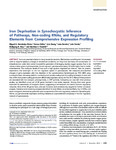Iron Deprivation in Synechocystis : Inference of Pathways, Non-coding RNAs, and Regulatory Elements from Comprehensive Expression Profiling
| dc.contributor.author | Hernández-Prieto, MA | |
| dc.contributor.author | Schön, V | |
| dc.contributor.author | Georg, J | |
| dc.contributor.author | Barreira, L | |
| dc.contributor.author | Varela, J | |
| dc.contributor.author | Hess, WR | |
| dc.contributor.author | Futschik, Matthias | |
| dc.date.accessioned | 2017-02-07T19:52:00Z | |
| dc.date.available | 2017-02-07T19:52:00Z | |
| dc.date.issued | 2012-12 | |
| dc.identifier.issn | 2160-1836 | |
| dc.identifier.issn | 2160-1836 | |
| dc.identifier.uri | http://hdl.handle.net/10026.1/8412 | |
| dc.description.abstract |
<jats:title>Abstract</jats:title><jats:p>Iron is an essential cofactor in many metabolic reactions. Mechanisms controlling iron homeostasis need to respond rapidly to changes in extracellular conditions, but they must also keep the concentration of intracellular iron under strict control to avoid the generation of damaging reactive oxygen species. Due to its role as a redox carrier in photosynthesis, the iron quota in cyanobacteria is about 10 times higher than in model enterobacteria. The molecular details of how such a high quota is regulated are obscure. Here we present experiments that shed light on the iron regulatory system in cyanobacteria. We measured time-resolved changes in gene expression after iron depletion in the cyanobacterium Synechocystis sp. PCC 6803 using a comprehensive microarray platform, monitoring both protein-coding and non-coding transcripts. In total, less than a fifth of all protein-coding genes were differentially expressed during the first 72 hr. Many of these proteins are associated with iron transport, photosynthesis, or ATP synthesis. Comparing our data with three previous studies, we identified a core set of 28 genes involved in iron stress response. Among them were genes important for assimilation of inorganic carbon, suggesting a link between the carbon and iron regulatory networks. Nine of the 28 genes have unknown functions and constitute key targets for further functional analysis. Statistical and clustering analyses identified 10 small RNAs, 62 antisense RNAs, four 5′UTRs, and seven intragenic elements as potential novel components of the iron regulatory network in Synechocystis. Hence, our genome-wide expression profiling indicates an unprecedented complexity in the iron regulatory network of cyanobacteria.</jats:p> | |
| dc.format.extent | 1475-1495 | |
| dc.format.medium | Print-Electronic | |
| dc.language | en | |
| dc.language.iso | en | |
| dc.publisher | Genetics Society of America | |
| dc.subject | iron homeostasis | |
| dc.subject | expression profiling | |
| dc.subject | regulation | |
| dc.subject | non-coding RNA | |
| dc.subject | cyanobacteria | |
| dc.title | Iron Deprivation in Synechocystis : Inference of Pathways, Non-coding RNAs, and Regulatory Elements from Comprehensive Expression Profiling | |
| dc.type | journal-article | |
| dc.type | Journal Article | |
| dc.type | Research Support, Non-U.S. Gov't | |
| plymouth.author-url | https://www.webofscience.com/api/gateway?GWVersion=2&SrcApp=PARTNER_APP&SrcAuth=LinksAMR&KeyUT=WOS:000312458000001&DestLinkType=FullRecord&DestApp=ALL_WOS&UsrCustomerID=11bb513d99f797142bcfeffcc58ea008 | |
| plymouth.issue | 12 | |
| plymouth.volume | 2 | |
| plymouth.publication-status | Published | |
| plymouth.journal | G3 : Genes, Genomes, Genetics | |
| dc.identifier.doi | 10.1534/g3.112.003863 | |
| plymouth.organisational-group | /Plymouth | |
| plymouth.organisational-group | /Plymouth/Faculty of Health | |
| plymouth.organisational-group | /Plymouth/Users by role | |
| dc.publisher.place | England | |
| dcterms.dateAccepted | 2012-09-28 | |
| dc.identifier.eissn | 2160-1836 | |
| dc.rights.embargoperiod | Not known | |
| rioxxterms.versionofrecord | 10.1534/g3.112.003863 | |
| rioxxterms.licenseref.uri | http://www.rioxx.net/licenses/all-rights-reserved | |
| rioxxterms.licenseref.startdate | 2012-12 | |
| rioxxterms.type | Journal Article/Review |


